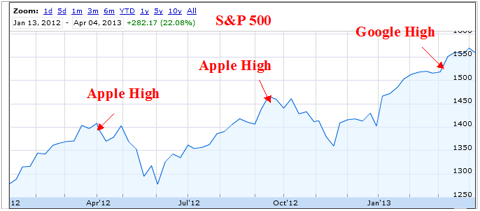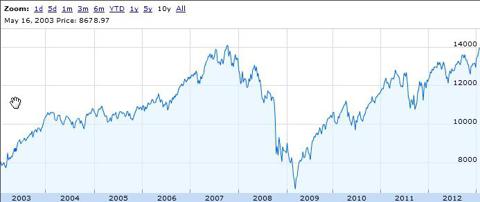 Generally, when you hear the words “perfect storm,” you tend to think of an unfortunate alignment of events that brings along some tragedy. While any of the events could have created its own tragedy the collusion results in something of enormous scale.
Generally, when you hear the words “perfect storm,” you tend to think of an unfortunate alignment of events that brings along some tragedy. While any of the events could have created its own tragedy the collusion results in something of enormous scale.
For those that believe in the wisdom that can be garnered from the study of history, thus far September 2013 has been at variance with the conventional wisdom that tell us September is the least investor friendly month of the year.
What has thus far made this September different, particularly in contrast to our experience this past August, has been a perfect storm that hasn’t come.
Yet, but the winds are blowing.
Barely three weeks ago we were all resolved to another bout of military action, this time in Syria. History does tend to indicate that markets don’t like the period that leads up to hostilities.
Then we learned that the likely leading contender to assume the Chairmanship of the Federal Reserve, Larry Summers, withdrew his name from consideration of the position that has yet to confirm that its current Chairman will be stepping down. For some reason, the markets didn’t like prospects of Larry Summers being in charge but certainly liked prospects of his being taken out of the equation.
Then we were ready to finally bite the bullet and hear that the Federal Reserve was going to reduce their purchase of debt obligations. Although they never used the word “taper” to describe that, they have made clear that they don’t want their actions to be considered as “tightening,” although easing on Quantitative Easing seems like tightening to me.
There’s not too much guidance that we can get from history on how the markets would respond to a “taper,” but the general consensus has been that our market climb over the past few years has in large part been due to the largesse of the Federal Reserve. Cutting off that Trillion dollars each year might drive interest rates higher and result in less money being pumped into equity markets.
What we didn’t know until the FOMC announcement this past Wednesday was what the market reaction would be to any announcement. Was the wide expectation for the announcement of the taper already built into the market? What became clear was that the market clearly continues to place great value on Quantitative Easing and expressed that value immediately.
As long as we’re looking at good news our deficit is coming down fast, employment seems to be climbing, the Presidents of the United States and Iran have become pen pals and all is good in the world.
The perfect storm of good news.
The question arises as to whether any eventual bad news is going to be met with investors jumping ship en masse. But there is still one thing missing from the equation. One thing that could bring us back to the reality that’s been missing for so long.
Today we got a glimpse of what’s been missing. The accelerant, if you will. With summer now officially over, at least as far as our elected officials go, the destructive games have been renewed and it seems as if this is just a replay of last year.
Government shutdowns, debt defaults and add threats to cut off funding for healthcare initiatives and you have the makings of the perfect storm, the bad kind, especially if another domino falls.
Somewhat fortuitously for me, at least, the end of the September 2013 option cycle has brought many assignments and as a result has tipped the balance in favor of cash over open positions.
At the moment, I can’t think of a better place to be sitting as we enter into the next few weeks and may find ourselves coming to the realization that what has seemed to be too good to be true may have been true but could only last for so long.
While I will have much more cash going into the October 2013 cycle than is usually the case and while I’m fully expecting that accelerant to spoil the party, I still don’t believe that this is the time for a complete buying boycott. Even in the middle of a storm there can be an oasis of calm.
As usual, the week’s potential stock selections are classified as being in Traditional, Double Dip Dividend, Momentum and “PEE” categories this week (see details).
After Friday’s loss, I have a difficult time in not being attracted to the idea of adding shares of Caterpillar (CAT). It has been everyone’s favorite stock to deride for its dependence on the Chinese economy and for its lack of proactive leadership in the past year. Jim Chanos publicly proclaimed his love for Caterpillar as his great short thesis for the coming year. Since it has trailed the S&P 500 by 16% on a year to date basis there may be good reason to believe that money goes into Caterpillar shares to die.
However, it has been a perfect stock with which to apply a serial covered option strategy. In 13 trades beginning July 2012, for example, it has demonstrated a 44.9% ROI, by simply buying shares, collecting dividends and premiums and then either re-purchasing shares or adding to existing shares. In that same time the index was up 28%, while Caterpillar has lost 3%.
It’s near cousin Deere (DE) also suffered heavily in Friday’s market and has also been an excellent covered option trade over the past year. Enhancing its appeal this week is that it goes ex-dividend. I currently own shares, but like Caterpillar, in smaller number than usual and purchases would provide the additional benefit of averaging down cost, although I rarely combine lots and sell options based on average cost.
Also going ex
-dividend this week is Dow Chemical (DOW). This has been one of those companies that for years has been one of my favorite to own using the covered option strategy. However, unlike many others, it hasn’t shown much propensity to return to lower price levels after assignment. I don’t particularly like admitting that there are some shares that don’t seem to obey the general rule of gravity, but Dow Chemical has been one of those of late. I also don’t like chasing such stocks particularly in advance of what may be a declining market. However, with the recent introduction of weekly options for Dow Chemical I may be more willing to take a short term position.
YUM Brands (YUM) is similar in that regard to Dow Chemical. I’ve been waiting for it to come down to lower price levels, but just as it had at those lower levels, it proved very resilient to any news that would send its shares downward for a sustained period. As with Caterpillar, YUM Brands is tethered to Chinese news, but even more so, as in addition to economic reports and it’s own metrics, it has to deal with health scares and various food safety issues that may have little to no direct relationship to the company. YUM Brands does help to kick off the next earnings season October 8th and also goes ex-dividend that same week.
Continuing along with that theme, UnitedHealth Group (UNH) just hasn’t returned to those levels at which I last owned shares. In fact, in this case it’s embarrassing just how far its shares have come and stayed. What I can say is that if membership in the Dow Jones Index was responsible, then perhaps I should have spent more time considering its new entrants. However, with the Affordable Care Act as backdrop and now it being held hostage by Congressional Republicans, shares have fallen about 6% in the past week.
Mosaic (MOS) is among the companies that saw its share price plummet upon news that the potash cartel was collapsing. Having owned much more expensive shares at that time, I purchased additional shares at the much lower level in the hope that their serial assignment or option premium generation would offset some of the paper losses on the older shares. Although that has been successful, I think there is continuing opportunity, even as Mosaic’s price slowly climbs as the cartel’s break-up may not be as likely as originally believed.
If you had just been dropped onto this planet and had never heard of Microsoft (MSFT) you might be excused for believing this it was a momentum kind of stock. Between the price bounces that came upon the announcement of the Nokia (NOK) purchase, CEO Ballmer’s retirement, Analyst’s Day and the announcement of a substantial dividend increase, it has gyrated with the best of them. Those kinds of gyrations, while staying within a nicely defined trading range are ideal for a covered option strategy.
Cypress Semiconductor (CY) goes ex-dividend this week. This is a stock that I frequently want to purchase but am most likely to do so when its purchase price is near a strike level. That’s especially true as volatility is low and there is less advantage toward the use of in the money options. With a nice dividend, healthy option premiums, good leadership and product ubiquity, this stock has traded reliably in the $10-12 range to also make it a very good covered option strategy stock selection.
Every week I feel a need to have something a little controversial, as long as there’s a reasonable chance of generating profit. The challenge is always in finding a balance to the risk and reward. This week, I was going to again include Cliffs Natural Resources, as I did the previous week, however a late plunge in share price, likely associated with reports that CHinese economic growth was not going to include industrial and construction related growth, led to the need to rollover those shares. I would have been happy to repurchase shares, but not quite as happy to add them.
Fortunately, there’s always JC Penney (JCP). It announced on Friday that it was seeking a new credit line, just as real estate concern Vornado (VNO) announced its sale of all its JC Penney stake at $13. Of course the real risk is in the company being unable to get the line it needs. While it does reportedly have nearly $2 billion in cash, no one wants to see starkly stocked shelves heading into the holidays. WHether through covered options or the sale of put options, JC Penney has enough uncertainty built into its future that the premium is enticing if you can accept the uncertainty and the accompanying risk.
Finally, I had shares of MetLife (MET) assigned this past week as it was among a handful of stocks that immediately suffered from the announcement that there would be no near term implementation of the “taper.” The thesis, probably a sound one was that with interest rates not likely to increase at the moment, insurance companies would likely derive less investment related income as the differential between what they earn and what they pay out wouldn’t be increasing.
As that component of the prefect storm is removed one would have to believe that among the beneficiaries would be MetLife.
Traditional Stocks: Caterpillar, MetLife, Microsoft, UnitedHealth Group
Momentum Stocks
: JC Penney, Mosaic, YUM Brands
Double Dip Dividend: Cypress Semiconductor (ex-div 9/24), Deere (ex-div 9/26), Dow Chemical (ex-div 9/26)
Premiums Enhanced by Earnings: none
Remember, these are just guidelines for the coming week. The above selections may be become actionable, most often coupling a share purchase with call option sales or the sale of covered put contracts, in adjustment to and consideration of market movements. The over-riding objective is to create a healthy income stream for the week with reduction of trading risk.
 Last week confirmed that I still like earnings season, which as behavioral adaptations go, is a good idea, as it never seems to end. Better to learn to like it than to fight it.
Last week confirmed that I still like earnings season, which as behavioral adaptations go, is a good idea, as it never seems to end. Better to learn to like it than to fight it.The table above may be used as a guide for determining which of selected companies may meet the risk–reward parameters that an individual sets, understanding that adjustments may need to be made as prices and, therefore, strike prices and premiums may change.

 Generally, when you hear the words “perfect storm,” you tend to think of an unfortunate alignment of events that brings along some tragedy. While any of the events could have created its own tragedy the collusion results in something of enormous scale.
Generally, when you hear the words “perfect storm,” you tend to think of an unfortunate alignment of events that brings along some tragedy. While any of the events could have created its own tragedy the collusion results in something of enormous scale. 






